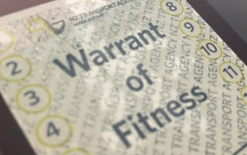WOF and COF changes on way

The coalition is accelerating progress on modernising New Zealand’s land-transport rules with consultation now under way on three areas of work.
A major area of focus is reviewing warrant of fitness (WOF) and certificate of fitness A (COF A) frequency and inspection requirements for light vehicles.
Also on the agenda are extra safety requirements for vehicles entering the fleet and simplifying heavy vehicle permitting.
James Meager, pictured, Associate Transport Minister, describes the WOF and COF A reviews as a “common-sense opportunity” to modernise the country’s vehicle-inspection approach.
He adds: “New Zealand has one of the most frequent regimes globally. We want to make sure we’re not placing unnecessary costs or time pressures on Kiwis while still keeping everyone safe on the road.
“We’re looking at how other jurisdictions handle this. For example, Europe checks light vehicles every two years. Most states in Australia and provinces in Canada only require a WOF when the vehicle changes ownership or when a defect is identified.”
The government is also investigating the case for mandating extra safety features in most vehicles entering our fleet, such as automatic emergency braking, lane-keep support and acoustic vehicle-alerting systems to further protect road users.
“These reforms are about bringing our land-transport regulation into the 21st century,” says Chris Bishop, Minister of Transport. “We want to remove costly inefficiencies and put money back into the pockets of Kiwis to drive our economy forward.
“These changes are about increasing our transport system’s productivity and safety. The current rules are riddled with outdated or nonsensical requirements which create unnecessary burdens for Kiwis.”
He adds the “simplification” of heavy-vehicle requirements is also on the table. This includes reviewing whether 50MAX trucks permits and the display of H signs are still needed.
“We’re also looking at more efficient options to update key log truck code of practice to reduce red tape and make it easier for industry to comply.”





